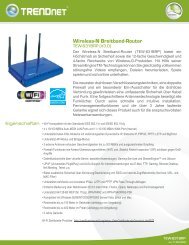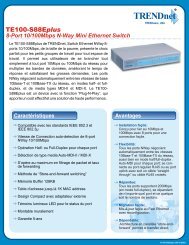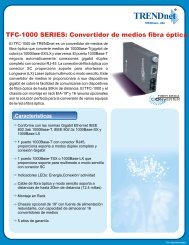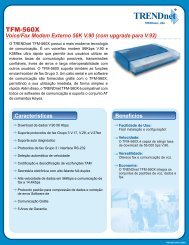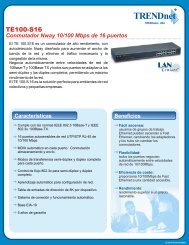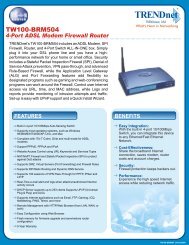Create successful ePaper yourself
Turn your PDF publications into a flip-book with our unique Google optimized e-Paper software.
Glossary<br />
Access Point<br />
Ad-Hoc Mode<br />
Term Definition<br />
Authentication<br />
Bridging<br />
CCK<br />
An access point is a bridging device for connecting a wired and wireless network together.<br />
Access points are typically wireless routers or stand-alone devices that plug into an Ethernet<br />
hub, switch, or router.<br />
Ad-Hoc Mode is also referred to as a “peer to peer” wireless network. By enabling ad-hoc mode<br />
in the wireless client utility, wireless PC's can communicate directly with one another without<br />
having to go through an access point.<br />
Determines a user's identity, as well as determining what a user is authorized to access, e.g. a<br />
financial database or a support knowledgebase. The most common form of authentication is<br />
user name and password, although this also provides the lowest level of security.<br />
Bridging is a dedicated wireless link between two or more access points. This wireless link is<br />
made when an access point takes the MAC address of the other access point and vice versa.<br />
CCK (Complimentary Code Keying) is a modulation scheme used with wireless networks<br />
(WLANs) that employ the IEEE 802.11b specification. A network using CCK can transfer<br />
more data per unit time for a given signal bandwidth than a network using the Barker code,<br />
because CCK makes more efficient use of the bit sequences.<br />
dBi The decibel units used to calculate the gain of an antenna.<br />
DBPSK<br />
DQPSK<br />
DSSS<br />
Encryption<br />
Gain<br />
v2.0906<br />
DBPSK (Differential Binary Phase Shift Keying) is a modulation technique used by IEEE<br />
802.11-compliant wireless LANs for transmission at 1 Mbps.<br />
DQPSK (Differential Quadrature Phase Shift Keying) is a modulation technique used by IEEE<br />
802.11-compliant wireless LANs for transmission at 2 Mbps.<br />
DSSS (Direct-Sequence Spread Spectrum) is a transmission technology used in WLAN<br />
(wireless LAN) transmissions where a data signal at the sending station is combined with a<br />
higher data rate bit sequence, or chipping code, that divides the user data according to a<br />
spreading ratio. The chipping code is a redundant bit pattern for each bit that is transmitted,<br />
which increases the signal's resistance to interference. If one or more bits in the pattern are<br />
damaged during transmission, the <strong>original</strong> data can be recovered due to the redundancy of<br />
the transmission.<br />
Encryption prevents any non-authorized party from reading or changing data. The level of<br />
protection provided by encryption is determined by an encryption algorithm.<br />
An increase in signal power, voltage, or current by an amplifier, expressed as the ratio of<br />
output to input.<br />
HotSpot A Hotspot provides the same functionality as an Access Point, but has added capabilities such<br />
as VLAN (Virtual Local Area Network) and multiple SSID broadcasting.<br />
IEEE IEEE (Institute of Electrical and Electronic Engineers) is an organization that sets system<br />
transmission standards. Most products that conform to the IEEE standard assure customers<br />
that products will be compatible with other vendor products.<br />
Infrastructure Mode Infrastructure Mode allows PC's to communicate with one another through the use of an<br />
access point. Each laptop or desktop wireless client adapter communicates with the access<br />
point, which can in turn provide access to the corporate network or Internet.<br />
<strong>TRENDnet</strong> <strong>Wi</strong>-<strong>Fi</strong> <strong>Tutorial</strong> 13



